BAMS Monthly Meeting
Brian Perry | Illuminating Fungi - the Science of Fungal Bioluminescence
338 Koshland Hall, UC Berkeley
Wednesday, May 8 | 7:30 - 9:30 pm
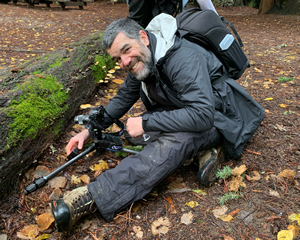
Fungal bioluminescence was first described by Aristotle (384-322 B.C.E.), and continues to fascinate and puzzle scientists today. While over 100 species of fungi are known to produce luminescent mushrooms or mycelium, the chemical and genetic basis of the light-producing reaction was only recently discovered, and the reason these fungi glow remains somewhat of a mystery. Come learn about our current understanding of the evolution, ecology and biochemistry of this phenomenon. And yes, there will be lots of pictures of glowing mushrooms!
Brian Perry is a Professor of Biology at California State University East Bay, and Director of the HAY Fungarium. He received his Master's Degree from San Francisco State University under the guidance of Dr. Dennis E. Desjardin, and his Ph.D. from Harvard University where he studied with Dr. Donald H. Pfister. Brian has been studying fungi since 1995, and has published over 45 papers in scientific journals. In addition to studying the evolution of fungal bioluminescence, he also conducts research on mushrooms and other fungi of Vanuatu, the assembly and biogeography of island fungal communities, endophytic fungi, and the systematics of Mycena and allied genera. Brian teaches several mycology courses at Cal State East Bay and the Sierra Nevada Field Campus.
Note: this meeting will be in 338 Koshland Hall. Entrance to Koshland Hall is on the plaza side. Doors open at 7:30. Meeting starts promptly at 8:00. If you've found mushrooms you'd like to identify, bring those along.
Tom Volk Memorial in Mycologia
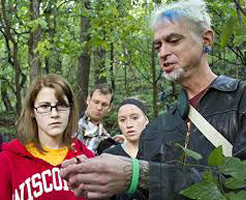
We just found out about this tribute to Tom in Mycologia, published last month, and written by Hal Burdsall, Dan Lindner, and Todd Osmundson. For those who didn't know him, Tom was a towering yet humble figure in North American mycology. He taught and inspired countless students as Professor of Mycology at UW LaCrosse, and volunteered thousands of hours towards helping others, whether by donating time to amateur mycology, or assisting his beloved Wisconsin marching band, Blue Stars Drum and Bugle Corps, in ways both small (helping to feed them at events) and large (financing a food truck). Tom always had time for the "little fun guy and gal," and was beloved by everyone, not just for his scholarship but for his character. What a shining light he was, and with a wicked sense of humor, too!
Tom spoke to BAMS three times: January 2010 on polypore taxonomy; January 2014 on the secret sex lives of fungi; and January 2016 on the seven deadly sins committed by fungi. Volk was a prominent figure in the North American Mycological Association and served as Institutional Trustee for over a decade. Click here to read the memorial in Mycologia.

Amatoxin: The Deadliest of All Mushroom Poisonings
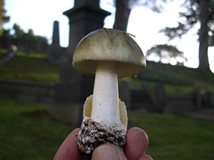
Debbie Viess has written a new modern treatment of amatoxin: what mushrooms contain it, mode of action, poisoning symptoms, and best treatments. Although amatoxin causes human and animal deaths around the world every year, with prompt care in a modern medical/veterinary facility, the chances of surviving and having a full recovery are quite good. Only around 12% of healthy adults poisoned will die or require a liver transplant. Without such care, human deaths are closer to 50%.
We lack good statistics for pet poisonings, but their poisonings are often more severe and more often fatal, but even in the case of dog poisonings, there are protocols available that can increase the rate of survival. To read this important new article, follow this link...

Sex and the Single Stinkhorn
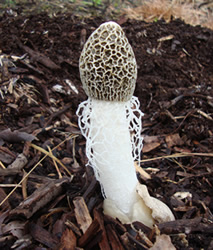
Some rumors need a strong denial. In this essay, Debbie Viess obliterates the proposition put forth in a sketchy study published in an obscure journal that a species of stinkhorn may cause spontaneous female arousal. The authors' attempt to wrap this ridiculous idea in Hawaiian myth is firmly debunked. Although first published in 2001, the idea that this phenomenon is real persists and occasionally gets notice on social media sites. To read Debbie's humorous and direct response, follow this link...
This article first appeared in Mushroom the Journal, Issue 114, Volume 31, No.4, Fall 2015, p. 16.
Further Reflections on Amanita muscaria as an Edible Species
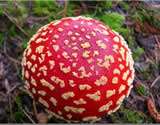
Here is a thoughtful response to the current push to eat Amanita muscaria, along with a history of its treatment in field guides, its toxins, and warnings about edibility. To read the article, follow this link...
This article first appeared in Mushroom The Journal, Issue 110, Fall 2011 - Winter 2012, p. 42.

The Bay Area Mycological Society (BAMS), established in 2006, is dedicated to the art and science of mushrooms. We hold our meetings at UC Berkeley. We hold local and long distance forays, participate in the Yosemite National Park Fungal Survey, and organize the Point Reyes Fungus Fairs and All California Club Forays.
We are affiliated with the North American Mycological Association. We host a lively online discussion group. Our members range from beginners to professionals in the field. We believe that everyone wants to learn, and has ideas to share. Join us.


